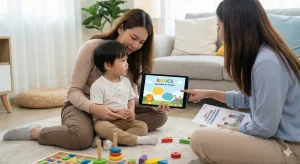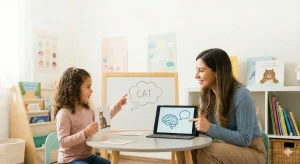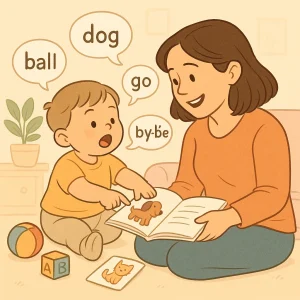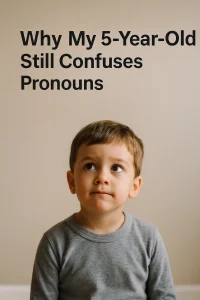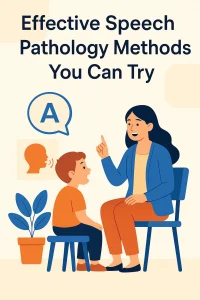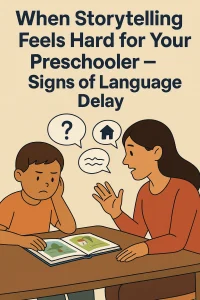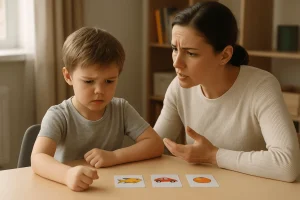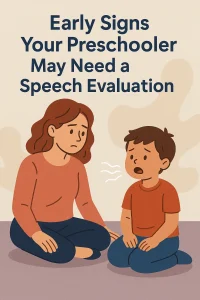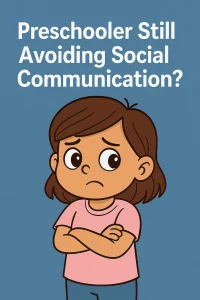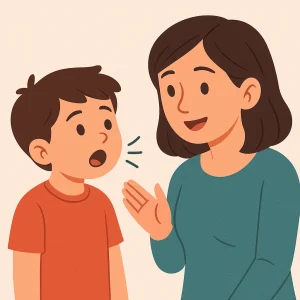Perfecting the /w/ Sound: Articulation Therapy Tips for Kids
Last Updated: August 10, 2024
Welcome to our guide on articulation therapy! If you’re noticing your child struggling with speech clarity, particularly with the /w/ sound, this resource is crafted for you. Mastering pronunciation early on is crucial for effective communication and self-confidence. This article offers straightforward, practical advice to assist your child in perfecting the /w/ sound. Whether they’re just starting to speak or need a little extra help, we’re here to support you with tips and techniques to enhance their speech development and confidence. Let’s dive into how you can help your child achieve clearer speech.
Understanding the /w/ Sound
What is the /w/ Sound?
The /w/ sound, as in words like “well” and “week,” is classified as a glide or semi-vowel. This is because, while it resembles a consonant, it shares many characteristics with vowels. When producing the /w/ sound, the vocal tract is more restricted compared to vowels, but not as much as with other consonants.
To produce the /w/ sound, your lips need to be rounded, forming a narrow opening at the back of your mouth with your tongue. This positioning is what gives the /w/ sound its unique quality, distinct from both vowels and other consonants.
When Do Children Typically Master the /w/ Sound?
Children generally start producing the /w/ sound around the age of two. By the time they reach three years old, most kids have mastered this sound and use it consistently in their speech. However, if your child is four years old and still having trouble with the /w/ sound, it might be a good idea to seek assistance from a speech-language pathologist. Early intervention can help address any issues before they affect the production of other sounds.
How the /w/ Sound is Produced
Articulators Involved
To produce the /w/ sound, several key parts of the mouth and throat, called articulators, work together. These include the jaw, lips, tongue, and velum.
- Jaw: The jaw is slightly closed but relaxed, providing a stable base for the other articulators to move correctly.
- Lips: The lips play a crucial role. They need to be pursed or rounded, almost as if you are about to kiss someone. This rounded shape creates one of the narrow spaces necessary for the /w/ sound.
- Tongue: The tongue is raised towards the roof of the mouth, near the back. This positioning creates another narrow space which helps shape the sound.
- Velum: Also known as the soft palate, the velum helps in controlling the airflow and ensuring the sound is produced correctly.
When these articulators work together, they form the unique /w/ sound.
Voiced Sound
The /w/ sound is a voiced sound, which means that your vocal cords vibrate when you produce it. You can feel this vibration by gently placing your hand on your throat while saying the /w/ sound. This is an excellent way to help children and even adults understand and feel how the sound should be produced.
Techniques for Teaching the /w/ Sound
Teaching the /w/ sound can be a fun and engaging process when approached step-by-step. Here’s a simple guide to help you through each stage of articulation therapy.
Progression in Articulation Therapy
When teaching the /w/ sound, it’s important to progress through several stages: isolation, syllables, words, phrases, and finally, conversation. Each stage builds on the previous one, helping your child master the sound in a structured way.
Isolation Level
Tips for Teaching the /w/ Sound in Isolation:
- Exaggerate Mouth Movements: Demonstrate the /w/ sound by exaggerating your mouth movements. Pucker your lips and make the sound slowly, showing your child exactly how it’s done.
- Visual Cues: Use a mirror so your child can see their own mouth movements and compare them to yours. This helps them understand the correct positioning of their lips and tongue.
- Verbal Cues: Clearly explain the steps involved in making the /w/ sound. For instance, “Round your lips like you’re blowing a kiss, and make the sound from your throat.”
- Tactile Cues: Encourage your child to place their hand on their throat to feel the vibration when making the /w/ sound. This helps them understand that it’s a voiced sound.
Syllable Level
Combining the /w/ Sound with Vowels:
- Start by pairing the /w/ sound with different vowels to create simple syllables like “wa,” “wo,” “we,” and “wi.”
- Use playful activities such as clapping or tapping to make practice enjoyable. For example, clap your hands each time you say a syllable together.
Word Level
Creating Word Lists:
- Develop lists of words that have the /w/ sound in initial, medial, and final positions.
- Initial Position: “water,” “window,” “watch.”
- Medial Position: “away,” “flower,” “sandwich.”
- Final Position: “cow,” “show,” “bow.”
Interactive Games:
- Guessing Games: Describe a word with the /w/ sound and have your child guess it. For example, “What is the cold season?” (Answer: winter).
- Picking Chits: Write words with the /w/ sound on small pieces of paper, mix them in a bowl, and take turns picking and saying the words aloud.
Phrase/Sentence Level
Introducing Phrases and Sentences:
- Begin with short phrases and sentences containing the /w/ sound, like “walk away” or “wide awake.”
- Gradually increase the complexity by using longer sentences and eventually paragraphs. For example, “I want waffles for breakfast” or “She puts money in her wallet.”
Conversation Level
Encouraging Natural Conversation:
- Encourage your child to use the /w/ sound in everyday conversation. This can be done by talking about their favorite things or describing pictures.
- Provide gentle reminders and prompts to correct mispronunciations. For instance, if they say “wabbit” instead of “rabbit,” gently correct them and have them repeat the word correctly.
- Gradually reduce these reminders as they become more proficient, encouraging them to monitor their own speech.
Table of /w/ Sound Word Lists
| Position | Example Words | Example Sentences |
|---|---|---|
| Initial | water, window, watch, well, wish, walk, wall, wing, warm | “I want to drink water.” “Look out the window.” “She watches the birds.” |
| Medial | away, flower, sandwich, awake, somewhere, always, reward, aware, highway | “The flower is blooming.” “He is always ready.” “She received a reward.” |
| Final | cow, show, bow, now, grow, follow, yellow, low, below | “The cow is in the field.” “Can you show me how?” “Follow the yellow arrow.” |
Common Challenges and Solutions
When working on articulation therapy for the /w/ sound, you may encounter some common challenges. Here’s how to address them effectively.
Addressing Substitutions and Errors
One of the most common issues children face is substituting the /w/ sound with other sounds, such as /r/. For example, they might say “wabbit” instead of “rabbit.” Here are some strategies to correct these errors:
- Consistent Practice: Regular practice is key. Set aside a specific time each day for speech practice. Consistency helps reinforce correct sound production.
- Reinforcement: Provide positive reinforcement when your child produces the /w/ sound correctly. This could be in the form of praise, stickers, or a small reward. Positive reinforcement encourages them to continue practicing.
- Corrective Feedback: Gently correct your child when they substitute the /w/ sound. For instance, if they say “wabbit,” you can say, “Did you mean rabbit? Let’s try saying that together.” This helps them become aware of their errors without feeling discouraged.
- Use of Visual and Tactile Cues: Remind your child to watch their mouth movements in a mirror and feel the vibration on their throat. These cues help them self-correct and understand how to produce the sound accurately.
Also read: Help Your Child Master the /r/ Sound (Easy Tips!)
Working with a Speech-Language Pathologist
While at-home practice is essential, there are times when professional help is necessary:
- Slow Progress: If your child is making slow progress despite consistent practice, it may be time to seek help from a speech-language pathologist. These professionals are trained to identify specific issues and provide targeted strategies to address them.
- Professional Assessment: A speech-language pathologist can assess your child’s speech development and create a personalized therapy plan. This ensures that your child receives the most effective and tailored support.
- Resources and Support from Wellness Hub: At Wellness Hub, we offer a range of resources and support for parents and children. Our expert team can guide you through the process, providing the tools and techniques you need to help your child succeed.
Encouragement and Motivation
Supporting your child’s journey in mastering the /w/ sound requires not only techniques and tools but also plenty of encouragement and motivation. Here’s how you can keep the process positive and effective.
Celebrating Small Wins
Progress in speech therapy can be gradual, but every small step counts. Here’s how to celebrate those small wins:
- Acknowledge Progress: Whether it’s correctly pronouncing the /w/ sound once or consistently improving, acknowledge these moments. Say things like, “I’m so proud of you for saying ‘water’ correctly today!”
- Positive Reinforcement: Use positive reinforcement to keep your child motivated. Rewards can be as simple as stickers, a favorite treat, or extra playtime. Positive reinforcement helps children associate their efforts with positive outcomes, encouraging them to keep trying.
Consistency and Patience
Consistency and patience are key to success in speech therapy. Here’s how to maintain them:
- Daily Practice: Set aside a specific time each day for practice. Consistent practice helps reinforce the new skills your child is learning. Even short, regular sessions are more effective than sporadic, longer ones.
- Stay Patient: Progress takes time. It’s normal for your child to have good days and challenging ones. Encourage them to keep going, and remind yourself that patience is part of the process.
- Encouraging Words: Offer words of encouragement regularly. Let your child know that it’s okay to make mistakes and that each attempt is a step towards improvement. Phrases like, “You’re doing great, keep it up!” can boost their confidence.
Conclusion
We hope this guide has equipped you with the knowledge and strategies to successfully navigate your child’s journey through mastering the /w/ sound. Remember, patience and consistency are key in the process of articulation therapy. Celebrate each small victory along the way and remain proactive in utilizing the techniques and tips shared. If challenges arise, don’t hesitate to seek help from professionals who can provide tailored support. For further assistance and resources, the Wellness Hub is always here to support your child’s speech development. Share your success stories or any questions in the comments—your insights could greatly benefit others in our community.
Frequently Asked Questions:
1. What is the /w/ sound in articulation therapy?
The /w/ sound is a glide or semi-vowel, similar to a vowel but with more restriction in the vocal tract. It is produced by rounding the lips and positioning the tongue close to the roof of the mouth while the vocal cords vibrate.
2. At what age should my child master the /w/ sound?
Children typically begin to produce the /w/ sound around the age of two and master it by the age of three. If your child is four years old and still struggling with the /w/ sound, it may be beneficial to seek help from a speech-language pathologist.
3. What are some effective techniques for teaching the /w/ sound?
Effective techniques include starting with the /w/ sound in isolation, using visual, verbal, and tactile cues, and progressing to syllables, words, phrases, and natural conversation. Consistent practice and positive reinforcement are key.
4. How can I use visual cues to help my child produce the /w/ sound?
Using a mirror can help your child see their mouth movements. Demonstrate the /w/ sound by exaggerating your mouth movements and pointing to your lips to show them the correct positioning.
5. What should I do if my child substitutes the /w/ sound with another sound?
Consistent practice, corrective feedback, and positive reinforcement can help address substitutions. Encourage your child to watch their mouth movements in a mirror and feel the vibration on their throat when producing.
6. When should I seek help from a speech-language pathologist?
If your child is making slow progress despite regular practice, it may be time to seek help from a speech-language pathologist. They can provide a professional assessment and create a personalized therapy plan.
7. How can I keep my child motivated during articulation therapy?
Celebrate small wins and provide positive reinforcement. Use playful activities and games to make practice enjoyable. Encourage consistent practice and offer words of encouragement to keep your child motivated.
8. What resources does Wellness Hub offer for speech development?
Wellness Hub provides a range of resources and support for parents and children, including expert guidance, helpful tools, and articles on speech development. Visit Wellness Hub for more information.
9. How can I get more information or support from Wellness Hub?
For additional support or resources, visit Wellness Hub. Our team is dedicated to helping you and your child achieve success in speech development. You can also leave feedback or questions in the comments section of our articles.
About the Author:
Anuradha Karanam
Speech-language pathologist (7+ years of experience)
Anuradha Karanam is a skilled speech-language pathologist with over 6 years of experience. Fluent in Tamil, Telugu, Hindi, and English, she specializes in parent counseling, speech sound disorders, fluency assessment, and speech-language evaluations. Anuradha excels at working with children with developmental disorders, offering creative and effective therapy programs. Currently, at Wellness Hub, she holds a BASLP degree and is registered with the RCI (CRR No A85500). Her patience, ambition, and dedication make her a trusted expert in her field.
Book your Free Consultation Today
Parent/Caregiver Info:
Client’s Details:
* Error Message
